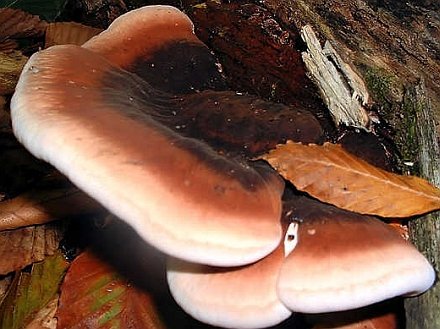The resinous polypore, Ischnoderma resinosum (Schrad.) P. Karst.
Classification
Kingdom Fungi
Phylum Basidiomycota
Class Basidiomycetes
Order Polyporales
Family Hapalopilaceae
Genus Ischnoderma
Synonyms
Boletus fuliginosus Scop.
Fl. carniol., Edn 2 (Vienna) 2: 470 (1772)
Boletus resinosus Schrad.
Spicil. Fl. Germ. 1: 171 (1794)
Fomes fuliginosus (Scop.) Fr.
Grevillea 13(no. 68): 119 (1885)
Fomes resinosus (Schrad.) Bigeard & H. Guill.
Fl. Champ. sup. France (Chalon-sur-Saône) 2: 356 (1913)
Fomitopsis resinosa (Schrad.) Rauschert
Feddes Repert. Spec. Nov. Regni Veg. 101(11-12): 641 (1990)
Ischnoderma fuliginosum (Scop.) Murrill
Bull. Torrey bot. Club 31(11): 606 (1904)
Ochroporus resinosus (Schrad.) J. Schröt.
Kryptogamenflora der Schweiz 3: 484 (1888) [1889]
Placodes resinosus (Schrad.) Quél.
Enchir. fung. (Paris): 170 (1886)
Polyporus fuliginosus (Scop.) Fr.
Epicr. syst. mycol. (Upsaliae): 451 (1838)
Polyporus resinosus (Schrad.) Fr.
Syst. mycol. (Lundae) 1: 361 (1821)
Scindalma fuliginosum (Scop.) Kuntze
Revis. gen. pl. (Leipzig) 3(2): 518 (1898)
Ungulina fuliginosa (Scop.) Pat.
Essai Tax. Hyménomyc.: 103 (1900)
Common names
Late fall polypore
Resinous polypore
Benzoin Bracket
Smolokorka buková (Czech)
Løv-tjæreporesvamp (Danish)
Polypore fuligineux (French)
Laubholzharzporling (German)
Gyantás kérgestapló (Hungarian)
Sørlig tjærekjuke (Norwegian)
Smolucha bukowa (Polish)
Ишнодерма смолистая/смолисто-пахучая/Трутовик смолистый (Russian)
Smolokôrovka buková (Slovak)
Sydlig sotticka (Swedish)

My name is Austin Collins.
I've dedicated my life to Mushrooms.
I believe Mushrooms are the best kept secret when it comes to health and well being.
For that reason, I would like to share a company with you that in my opinion makes the best mushroom products on the market.
The company is called Noomadic Herbals, my favorite supplement they make is called "Mushroom Total".
I take their products every day and they have helped me think better and have more energy. Give them a try.
-Austin
Description
Fruiting body: 5-15 cm diameter x 0.5-3 cm thick, semicircular, sessile, soft and fleshy when fresh and with an anise-like odor; often exuding droplets when young; drying hard, imbricate, effused-reflexed or entirely resupinate, applanate or dimidiate, surface becoming rugose, zonate in mature plants; drying brown, some zones blackish; context fleshy in fresh plants, drying firm and fragile, 3-15 mm thick, buff to tawny-olivaceous.
Tubes: whitish or brownish grey, 2-6 mm long, wall thin, entire.
Pores: pores whitish-cream, dark grey-brown when dried or bruised, round to angular, 4-6 per mm.

Spore print: white.
Spores: allantoid to cylindric, hyaline, smooth, 4-7 x 1.5-2.5 µm.
Edibility: edible when young, but tough and corky when older.
Habitat: solitary to several on rotten wood of broadleaf and coniferous trees; fruiting summer and fall.
The resinous polypore has demonstrated the ability to effectively decolorize a wide spectrum of chemically and synthetically different various synthetic dyes such as Orange G, Amaranth, Remazol Brilliant Blue R, Cu-phthalocyanin and Poly R-478 (Eichlerová et al., 2005 and 2006). These dyes are environmental pollutants, usually carcinogenic or mutagenic, and difficult to remove from the environment.
Description adapted from Shope (1931) and Arora (1986), p. 573.
Bioactive compounds
Lectins
A considerable amount of work has been done to elucidate the properties of the lectin from I. resinosum. The lectin (a dimer of two identical 16 kDa subunits) is inhibited by the monosaccharide β-galactoside, and to a lesser extent by fucose and l-arabinose (Kawagishi and Mizuno, 1988). Later chemical modification and NMR studies showed that a tyrosine residue is in the carbohydrate-binding site of the lectin (Kawagishi and Mori, 1991).
Medicinal properties
Antitumor effects
Polysaccharides extracted from the mycelial culture of I. resinosum and administered intraperitoneally into white mice at a dosage of 300 mg/kg inhibited the growth of Sarcoma 180 and Ehrlich solid cancers by 70% and 80%, respectively (Ohtsuka et al., 1973).
Links
References
Arora D. (1986).
Mushrooms demystified.
Berkeley: Ten speed press. (959 pp)
Eichlerová I, Homolka L, Lisá L, Nerud F.
Orange G and Remazol Brilliant Blue R decolorization by white rot fungi Dichomitus squalens, Ischnoderma resinosum and Pleurotus calyptratus.
Chemosphere. 2005 60(3):398-404.
Pubmed
Eichlerová I, Homolka L, Nerud F.
Evaluation of synthetic dye decolorization capacity in Ischnoderma resinosum.
J Ind Microbiol Biotechnol. 2006 33(9):759-66.
Pubmed
Kawagishi H, Mizuno T.
Purification and properties of a β-galactosyl-specific lectin from the fruiting bodies of Ischnoderma resinosus.
FEBS Letters. 1988 227:99-102.
Kawagishi H, Mori H.
Chemical modification and NMR studies on a mushroom lectin Ischnoderma resinosum agglutinin IRA.
Biochimica et Biophysica Acta. 1991 1076(2):179-86.
Pubmed
Kawagishi H.
Mushroom lectins.
Food Reviews International. 1995 11:63-68.
Ohtsuka S, Ueno S, Yoshikumi C, Hirose F, Ohmura Y, Wada T, Fujii T, Takahashi E.
Polysaccharides having an anticarcinogenic effect and a method of producing them from species of Basidiomycetes.
UK Patent 1331513, 26 September 1973.
Shope PF.
The Polyporaceae of Colorado.
Annals of the Missouri Botanical Garden. 1931 18(3):287-456.
Wang H, Ng TB, Ooi VEC.
Lectins from mushrooms.
Mycological Research. 1998 102(8):897-906.





can you make a duel extract tincture using this mushroom
Don’t see why not
We have eaten soft margins of this abundant fungus for years, misnamed for “late fall” as around here it’s more late summer, with pleasure and health benefit: I know from its positive influence after eating on my and my spouse’s muscle strength capacity, that it would be called a “spleen” tonic per oriental medicine categories. Anecdote maybe of interest: we’ve been cutting and hauling wood for our wood stove unwanted by others who call us to do so, I handle heavier pieces and spouse lighter. One day after 1st consumption of this, I noticed her carrying a very large piece uncharacteristically, which she had no thought as normally of not being able to do! I use a knife to cut in lightly perpendicular to the edge as far until resistance is met, beyond which it would be too tough for culinary use. I then cut off margin to the extent of 1st cut parallel to the edge, then cook with good oil & salt and a bit of water to start, and enjoy. Yet to try in alcohol. Last year a relative paucity, I hope his year renewed. Your website appreciated.